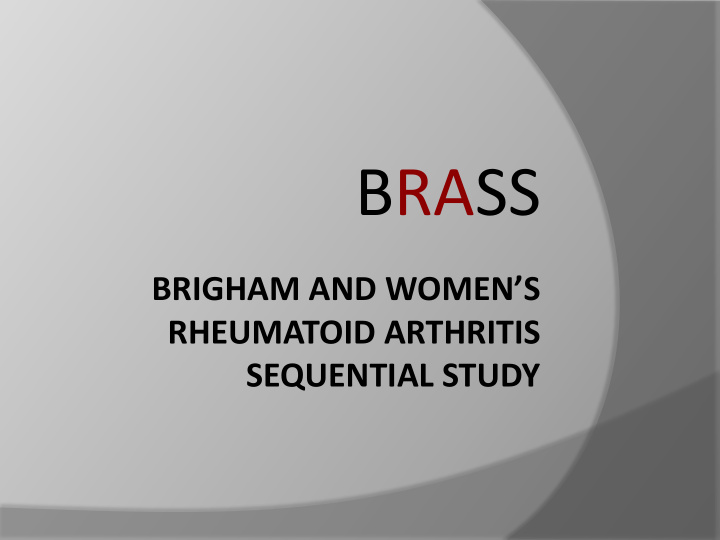



BRASS BRIGHAM AND WOMEN’S RHEUMATOID ARTHRITIS SEQUENTIAL STUDY
BRASS Registry Enrollment Began in March 2003 • Prospective follow-up for 15 years 1468 recruited to date • • 30 rheumatologists have contributed patients > 90% approached will sign up • • 6 month follow-up (86%) 1 year follow-up (>80%) • 680 still enrolled •
Original Scientific Aims • Identify markers of disease progression • Monitor markers for drug response • Examine pathogenic mechanisms via hypothesis driven experiments • Broaden our understanding of the epidemiology of RA
Structure of the BRASS Registry Data/Specimens Registry Structure Collected Physician data (annually) Patient reported data (6 months) 1461 RA patient DNA (twice) BRASS (15% new onset RA) RNA (annually) Serum (annually) Plasma (annually)
BRASS Protocol Patient Data Collection Occurs Every 6 months 6 Months 18 Months 30 Months mailed mailed mailed (-2 wks/+3 mos) (-2 wks/+3 mos) (-2 wks/+3 mos) Recall Recall Recall Recall Recall Recall Recall Baseline 1 Year 2 Years 3 Years Before BRASS (-3 mos/+6 mos) (-3 mos/+6 mos) (-3 mos/+6 mos) enrollment Physician Domains and Labs Measured at Baseline and Yearly If annual visit and semi-annual mailing will overlap (with-in 2 months), in-person visit takes priority and mailing will not be done. Hand X-rays done at baseline, 2yr, 5yr, 7yr, 10yr, 12yr, and 15yr ( ± 3 months)
Data Collection (over 2000 variables) • Demographics General Health • • Current Medications Past Medications • • Validated Scales MDHAQ, SF-12, MHI-5, PHQ-9, EQ-5D, RADAI, Arthritis Self-Efficacy, MOS Sleep Scale, Widespread Pain, Dyspnea Questionnaire
Brass Physician Domains Physician Domains Baseline Annual Inclusion Criteria Health & Symptoms Morning Stiffness VAS Infection/Opportunistic Infections Extra-Articular Manifestations Co-morbidities/drug toxicities 28 Joint Count Medication Changes Start Stop/reason Change/reason
Annual Study Blood Draw • DNA (visits 1-2 only) • Serum • Plasma • Pax Gene Tubes (RNA)
Radiographs • Collected at study baseline, year 2, year 5, year 7, year 10, year 12 and year 15 Sharp scores are available on • Baseline (N = 1175) Year 2 (N = 786) Year 5 (N= 438) Year 7 (N = 210) Year 10 (N = 111) • ICC • Total Sharp Score = 0.975 • Erosions = 0.962 • Joint Space Narrowing = 0.977
Sharp Score Data N = 1175; Mean = 25.9 ( ± 45.0); Median = 5 (IQR 0-28) Distribution of total_sharp_score_A 60 50 40 Percent 30 20 10 0 0 15 30 45 60 75 90 105 120 135 150 165 180 195 210 225 240 255 270 total_sharp_score_A
Year 2 Sharp Score Data N = 786; Mean = 27.9 ( ± 46.1); Median = 6.5 (IQR 0-32) Distribution of total_sharp_score_B 60 50 40 Percent 30 20 10 0 0 15 30 45 60 75 90 105 120 135 150 165 180 195 210 225 240 255 270 total_sharp_score_B
Year 5 Sharp Score Data N = 438; Mean = 31.8 ( ± 46.7); Median = 10 (IQR 1-41) Distribution of total_sharp_score_C 60 50 40 Percent 30 20 10 0 0 15 30 45 60 75 90 105 120 135 150 165 180 195 210 225 240 255 270 total_sharp_score_C
Distribution of Change in Sharp Score between Baseline and Year 2 Distribution of diff_ab 100 80 60 Percent 40 20 0 -7.5 -6.0 -4.5 -3.0 -1.5 0.0 1.5 3.0 4.5 6.0 7.5 9.0 10.5 12.0 13.5 15.0 16.5 18.0 Change between 1st and 2nd Sharp Score per Year
Distribution of Change in Sharp Score Between Year 2 and Year 5 Distribution of diff_bc 100 80 60 Percent 40 20 0 -7.5 -6.0 -4.5 -3.0 -1.5 0.0 1.5 3.0 4.5 6.0 7.5 9.0 10.5 12.0 13.5 15.0 16.5 18.0 Change between 2nd and 3rd Sharp Score per Year
Distribution of Annual Change in Sharp Score Between Baseline and Year 5
Recommend
More recommend